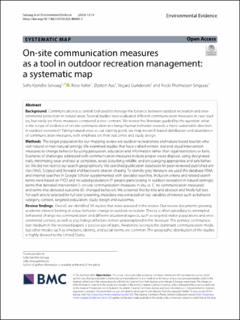| dc.description.abstract | Background Communication is a central tool used to manage the balance between outdoor recreation and environmental protection in natural areas. Several studies have evaluated diferent communication measures in case studies, but rarely are these measures compared across contexts. We review the literature guided by the question: what is the scope of evidence of on-site communication to change human behavior towards a more sustainable direction in outdoor recreation? Taking natural areas as our starting point, we map research-based distribution and abundance of communication measures, with emphasis on their outcomes and study design. Methods The target population for our mapping review are outdoor recreationists and nature-based tourists who visit natural or near-natural settings. We examined studies that have crafted written, oral and visual intervention measures to change behavior by using persuasion, education and information rather than legal restrictions or bans. Examples of challenges addressed with communication measures include proper waste disposal, using designated trails, minimizing wear and tear at campsites, avoid disturbing wildlife, and encouraging appropriate and safe behavior. We did not restrict our search geographically. We searched publication databases for peer-reviewed published articles (WoS, Scopus) and forward and backward citation chasing. To identify grey literature we used the database IRMA and internet searches in Google Scholar supplemented with specialist searches. Inclusion criteria and related search terms were based on PICO and included population (P: people participating in outdoor recreation in natural settings), terms that denoted intervention (I: on-site communication measures in situ vs. C: no communication measures) and terms that denoted outcome (O: changed behavior). We screened frst by title and abstract and fnally full text. For each article selected for full-text screening, metadata was extracted on key variables of interest such as behavior category, context, targeted population, study design and outcomes. Review fndings Overall, we identifed 54 studies that were assessed in the review. Our review documents growing academic interest looking at actual behavior change in outdoor recreation. Theory is often subsidiary to attempted behavioral change via communication and diferent situational aspects, such as targeted visitor populations and environmental context, as well as psychological factors remain underexplored in the literature. The primary communication medium in the reviewed papers is passive use of signs. Awareness raising is the dominant communication mode, but other modes such as emotions, identity, and social norms are common. The geographic distribution of the studies is highly skewed to the United States. Conclusions The amassed studies have an uneven focus on diferent settings and mediums used to change behavior. Research could beneft from investigating diferent contexts and the state of the natural environment before and after interventions. We advocate for casting a wider disciplinary net and interest in qualitative investigations to produce data-rich studies of where and how sustainable behavior is encouraged and eventually achieved. Collectively, diferent disciplinary perspectives are required to understand the aspects that contribute to sustainable, and sustained, behavior change. It is important to distinguish what aspects of behavior change could be generalized across settings, and which purely contextual aspects drive behavior change. Keywords Behavior psychology, Persuasion, Visitor management, Communication theory, Conservation messaging, Conservation psychology | |
